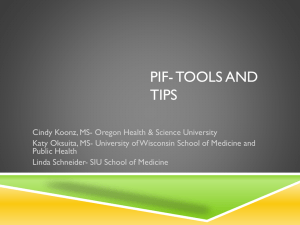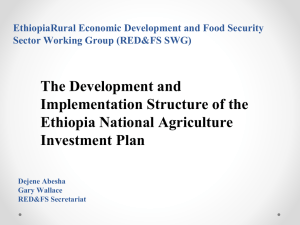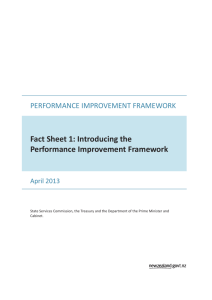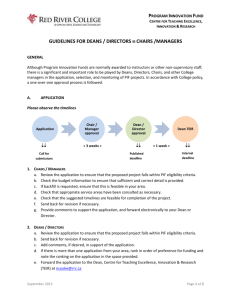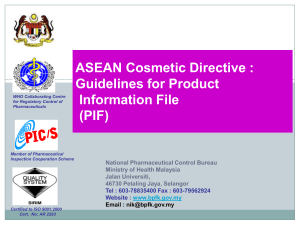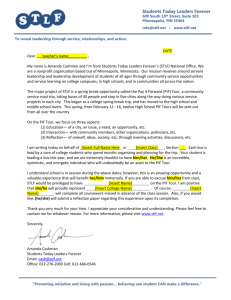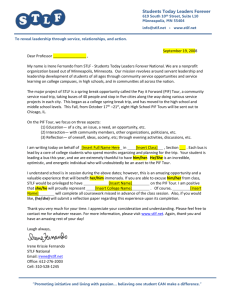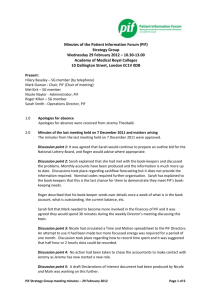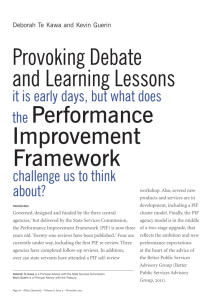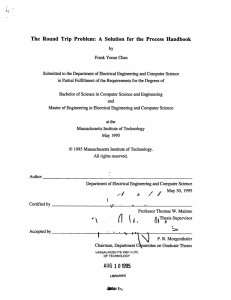Fact Sheet 4: What is the Four
advertisement
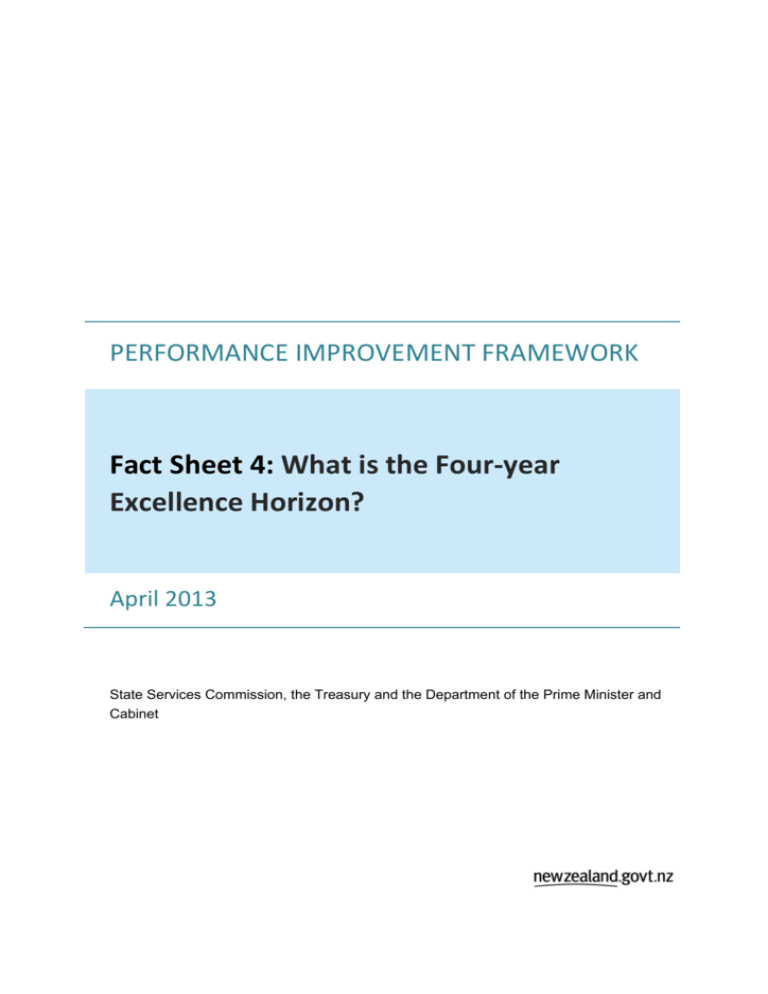
PERFORMANCE IMPROVEMENT FRAMEWORK Fact Sheet 4: What is the Four‐year Excellence Horizon? April 2013 State Services Commission, the Treasury and the Department of the Prime Minister and Cabinet What is the Four‐year Excellence Horizon? Perhaps for the foreseeable future, countries, businesses, non‐government organisations (NGOs), communities, households and families – New Zealand as a whole – will face challenges, which collectively are certainly bigger and more complex than what we have dealt with before. It is no different for the State Services; each senior leadership team is facing challenges quite different to those faced by previous chief executives and senior leaders. The Four‐year Excellence Horizon helps agencies to understand those changes. It is a strategic narrative written by the Lead Reviewers as a way for a senior team to understand and stay ahead of emerging opportunities and to respond quickly to unexpected issues. In many ways it is an aggregation of the dialogue between the Lead Reviewers and the people they engage with throughout a Performance Improvement Framework (PIF) Review. The reason it is so important is that the performance of the agency is judged against this future narrative – not just its previous performance. The Four‐year Excellence Horizon is not an environmental scan. It is not a SWOT analysis. It is particular to the agency’s near‐future or medium‐term context. While this is a recent innovation, senior teams already report that the approach deepens their understanding of how to be strategic and manage strategic change programmes. Others report that it gives them an appreciation of where the opportunities in their agencies, sectors and clusters lie and offer some big ideas on how to capture the opportunities. However, it is more than just a strategic statement. It is also a distillation of the critical shift that an agency needs to make to be successful in four years’ time. It does this by focussing on four areas: environment, business strategy, operating model and change capability. Its purpose is to give the chief executive and senior leaders a degree of clarity about the most important issues they need to work on to lift their performance, plus a sense of what it might actually look like if they were to achieve it. The first Four‐year Excellence Horizon was published in the Ministry of Economic Development PIF Review. Every other report since then includes these innovations. The exemplar is probably the horizon developed for and with the Ministry of Justice. See www.ssc.govt.nz/pif for a link to the reports. To learn more about how to use these innovations in a PIF Self‐review, email the PIF team to register for the next Self‐review workshop: performance.improvement.framework@ssc.govt.nz. FACT SHEET 4: WHAT IS THE FOUR‐YEAR EXCELLENCE HORIZON? – APRIL 2013 1 Why was the Performance Improvement Framework introduced? When Iain Rennie became the State Services Commissioner he was concerned that the public service was not perceived as taking ownership of its own performance improvement. He noted there were plenty of reports from external agencies and lobby groups, which were often critical of the public service. He felt many of them did not recognise the real strength of the public service and equally he wanted to move the culture of the public service towards continuous improvement and innovation. What are the origins of the Performance Improvement Framework? In 2009, Iain Rennie and the then Chief Executive of the Department of the Prime Minister and Cabinet, now Sir Maarten Wevers, travelled to the United Kingdom to meet with the Cabinet Secretary of the British Civil Service. The origins of the Performance Improvement Framework (PIF) are in those discussions with the then Cabinet Secretary, and now Right Honourable, Lord Gus O’Donnell. On their return to New Zealand, Iain and Sir Maarten commissioned a team from across the State Services to take the best of the United Kingdom’s Capability Review Programme and the best of the organisational improvement models from the New Zealand private sector, as well as methodologies from other jurisdictions, and adapt them to the New Zealand public management system. What findings are emerging? We do a number of things really well. We are responsive to Ministers. We are good at delivering against government priorities. We work well with a number of external stakeholders and we are good around the probity of our financial management system. These are all good characteristics of the New Zealand public management system. Where do we need to do better? So far the Reviews have a very common theme. They show the need for us as a system, ie, the wider State Services, to get better at working together. We also need to take a longer‐ term view to what we do; this means anticipating the issues that the State Services need to deliver on for New Zealanders in the future. For some agencies, it is clear they can do better at managing and developing their people. FACT SHEET 4: WHAT IS THE FOUR‐YEAR EXCELLENCE HORIZON? – APRIL 2013 2 What are the benefits of PIF Reviews to central agencies? The central agencies get a good picture of what is good about the New Zealand public management system and what needs to improve. Central agency officials would frequently get asked ‘who is good at financial management?’ or ‘who is good at setting strategy?’ Up until now there has been no way they could point to the areas of demonstrable and evidential strength. Now they can. Before PIF everyone had their own anecdotes about what needed to be done better. For central agency officials PIF gives a system‐wide diagnosis about what is good and where the system can improve. What is the benefit for Ministers? Ministers get assurance that the agencies they are responsible for are constantly looking for ways to improve how they do business and deliver value for the taxpayers’ investment in them. Ministers also get independent assurance, as the PIF Reviews are undertaken by external expert parties. What about the public? The public is able to see that the State Services are ‘on the move’ and are serious about the services it delivers and how these are delivered. The public can see that the State Services are continuously seeking to improve and are transparent about that journey. What do you see as the future direction? PIF will continuously be reviewed. Every time we do a Review we learn something and we seek to build that into our own continuous improvement process. With the advent, for example, of the Better Public Services programme, we are seeking to shift the bar in respect of standards of performance. From our point of view, Better Public Services and PIF examine the same drivers. Where PIF is all about jobs we do, and improving the workplaces for public servants so they can do their jobs better, Better Public Services is also about improving what we do on behalf of, and for, New Zealanders. Performance Improvement Framework: Continuous improvement The PIF already has a number of dimensions to it. Agencies conduct Self‐reviews where they rate themselves against the Agency Model. For many this is a precursor to a PIF Review. An agency that is formally reviewed will also undertake a Follow‐up Review, usually 12‐18 months later, which reviews the progress the agency has made since the PIF Review. In addition, ten PIF Elements will be upgraded between now and the end of April 2013. As part of this guidance release three PIF Elements are upgraded. Those elements are Asset Management and Financial Management, as well as Efficiency. FACT SHEET 4: WHAT IS THE FOUR‐YEAR EXCELLENCE HORIZON? – APRIL 2013 3 Successful agencies need their finance functions to look beyond the traditional core functions to use their financial acumen and insight to drive new value and higher levels of business transformation and performance. A close reading of the current upgrades place more weighting on the use of financial management information and advice for operational and strategic purposes and on the proactive role the finance function needs to play in decisions around creating value for money and leading strategic financial management disciplines in the agency. Performance Improvement Framework: Crown entities We have already started rolling out PIF to the Crown entity sector. Both the New Zealand Transport Agency and New Zealand Trade and Enterprise have been reviewed. Over the next two or three years, as we complete reviews for the core public service, we are increasingly wanting to focus on the wider Crown entity sector. For more information More information is available at www.ssc.govt.nz/pif. A new guidance series was released in April 2013. It reflects developments in the suite of Performance Improvement Framework products and services. As with any good performance improvement tool, PIF will continue to improve to meet the needs of Ministers, the public, chief executives, senior leaders and agencies in the wider State Services. To contact the PIF team email performance.improvement.framework@ssc.govt.nz. FACT SHEET 4: WHAT IS THE FOUR‐YEAR EXCELLENCE HORIZON? – APRIL 2013 4

